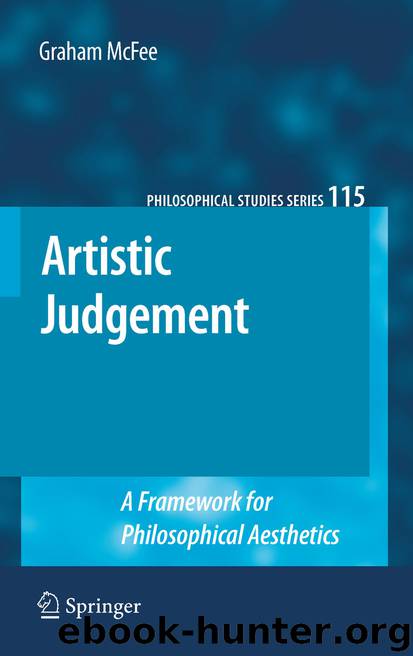Artistic Judgement by Graham McFee

Author:Graham McFee
Language: eng
Format: epub
Publisher: Springer Netherlands, Dordrecht
4.3 The Embodiment of Artistic Meaning
Artworks have some specific ‘embodiment’ (whether in pigment on canvas, or a block of marble, or words on a page, or sounds from an orchestra, or the movements of bodies, or some such) in which, as Urmson (1976: 243) puts it, “the witnessable work consists”. Of course, identifying that embodiment exactly, or recognizing its relation to the artwork, may be a complex matter. For instance, danceworks are (arguably: UD: 88–90) multiple ‘objects’, existing through many performances: so any account of their embodiment must respect these facts.
It might be argued that embodiment is not crucial for various artworks—say, Conceptual art, or various Readymades. But, first, for some works, such as Carl André’s Equivalent VIII (the bricks in the Tate Modern Gallery, London), the specific details of embodiment may not be fixed by the artist—in this case, he just ordered the bricks. Yet the work is embodied in those bricks: without them, it is an idea (or joke). And if that embodiment permits other bricks to be substituted under certain, specified circumstances, the point is unaffected. Second, the place of the sensuous properties of the embodied object can be over-rated: to just enjoy the sensuous surface of artworks is treating the music as birdsong. Third, it seems too glib to dismiss forms X, Y, and Z (say, Conceptual art or Readymades) as art just because our legitimate or appropriate concern with them is not obviously with sensuous appearances. Such a concern, even were it typically true of artworks, would be so only defeasibly!
So stressing embodiment at best draws two contrasts. First, the artwork, though meaning-bearing, differs from (say) the report of a road accident: the precise details of the artwork have an importance, bearing on that work’s meaning. Other accident reports could be different-but-equally-good. But to say, “Well, you can’t get that Dickens novel, so try another one” is not to do full justice to the artwork (see Beardsmore, 1971: 17–1811). For the meaning of that artwork is made concrete in the work itself, where only that concretization counts as bearing that meaning.12 Second, the emphasis on embodiment allows due weight to an artwork’s sensuous features, by stressing the need for direct confrontation with artworks (via the appropriate perceptual modality): the contrast might be with the gallery-goer who never takes his nose from the catalogue—he sees no art!
Then the conclusion that artworks are not ‘paraphrasable’ is not an empirical discovery, based on considering lots of cases and trying hard to render them into another form, either art or non-art. Instead, it reflects a commitment on our part, an element of the conception of art at work here. For, suppose two art-objects (say) did have completely the same meaning, such that we could say, correctly, “if you cannot get one, get the other—they amount to exactly the same thing”. That would offer us a basis for regarding these as instantiating one artwork, rather than as separable works. Our argument begins from reflection on authorship: if the first work
Download
This site does not store any files on its server. We only index and link to content provided by other sites. Please contact the content providers to delete copyright contents if any and email us, we'll remove relevant links or contents immediately.
Aircraft Design of WWII: A Sketchbook by Lockheed Aircraft Corporation(32210)
The Great Music City by Andrea Baker(31327)
Call Me by Your Name by André Aciman(20371)
The Secret History by Donna Tartt(18843)
The Art of Boudoir Photography: How to Create Stunning Photographs of Women by Christa Meola(18536)
Shoot Sexy by Ryan Armbrust(17654)
Plagued by Fire by Paul Hendrickson(17329)
Portrait Mastery in Black & White: Learn the Signature Style of a Legendary Photographer by Tim Kelly(16952)
Adobe Camera Raw For Digital Photographers Only by Rob Sheppard(16904)
Photographically Speaking: A Deeper Look at Creating Stronger Images (Eva Spring's Library) by David duChemin(16622)
Ready Player One by Cline Ernest(14522)
Pimp by Iceberg Slim(14382)
Bombshells: Glamour Girls of a Lifetime by Sullivan Steve(13972)
The Goal (Off-Campus #4) by Elle Kennedy(13542)
Art Nude Photography Explained: How to Photograph and Understand Great Art Nude Images by Simon Walden(12974)
Kathy Andrews Collection by Kathy Andrews(11726)
The Priory of the Orange Tree by Samantha Shannon(8889)
The remains of the day by Kazuo Ishiguro(8818)
Thirteen Reasons Why by Jay Asher(8792)
